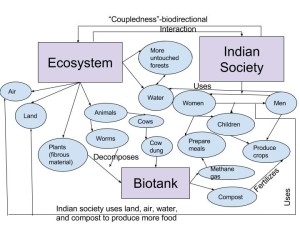The main parts of my diagram are the Indian Society and the Ecosystem. There is a “coupledness”, biodirectional interaction, or give-and-take relationship between these two important elements. The ecosystem is made up of (but not limited to) plants, animals, water, air, land, and forests. Women are the principal caregivers in this society and therefore do almost all of the cooking. They have tapped the use of “Biotanks” which helps to preserve the ecosystem. The social organization of the Indian society is such that women and children collect the dead fibrous plants materials, cow dung found in their immediate locals, and worms and add these parts of their ecosystem to their Biotank. The women then use two main by-products of the Biotank: methane gas and compost. They use the methane gas to cook their meals (it is kinder to the atmosphere than wood stoves) and compost from the Biotank to fertilize their crops. This use of a Biotank is much more efficient and kind to their ecosystem than past methods used to sustain Indian family members.
My “Biogas Systems in India” diagram is very similar to the one shown in Marten’s, “What is Human Ecology?” I added the term “coupledness” between the two main parts of my diagram, the Ecosystem and Indian Society, which stresses their interaction. However, the way that I arranged my diagram did not lend itself to showing all of the positive and negative feedback loops and/or interactions between the parts as well as did Marten’s diagram. All in all, both diagrams show that the Indian society and ecosystem rely upon each other for a healthy survival.


Hi, Lisa,
My name is Harrison, and I love the simplistic approach to your diagram. Which, by the way, I appreciate your reply to mine! Explaining the interactions between both the ecosystem and society was brilliantly orchestrated with the label of “bio-directional interaction”. Delving into each detail looks similar to Marten’s, as you said, but collaging it together into one gave it a more in depth analysis, I think. Nice job!
– Harrison
Lisa,
It is nice to get a chance to read your work as I do not believe we have had a class together in the past. I think your system is very detailed and unlike many of the other diagrams, includes men on it as well. I did not consider the role that men had in producing crops based on the video so it just shows one how different perspectives exist on the same subject. I also like that you went one step further and added middle steps such as works, air, and land. Very detailed and neat. When you get a second, take a look at mine and let me know what you think: http://geog030.dutton.psu.edu/2016/01/25/karolina-powell-lesson-2/
Thanks for your post,
Karolina Powell